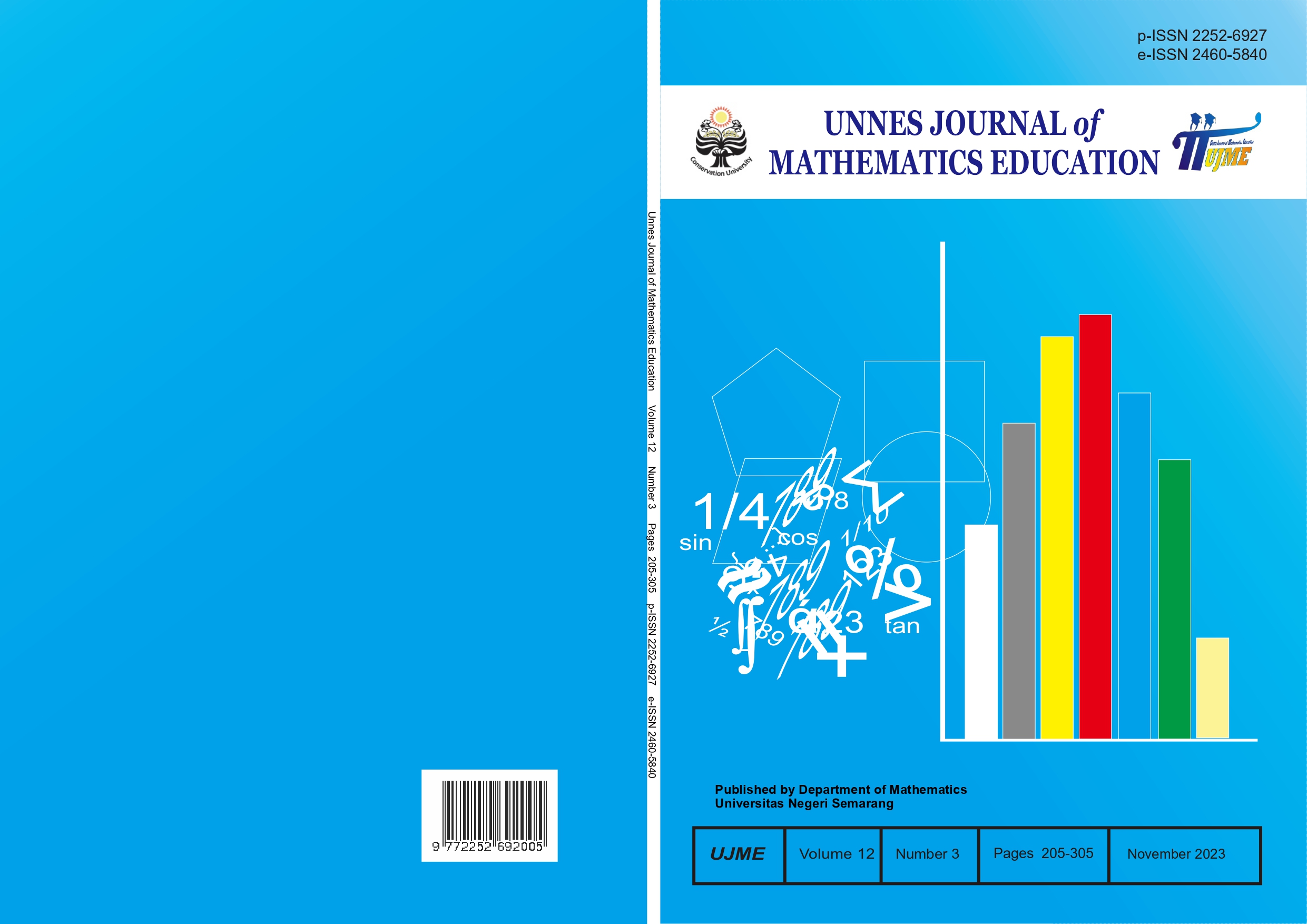Mathematical Representation Ability in Terms of Students’ Learning Independence in Project Based Learning Model Assisted by Google Sites
##plugins.themes.academic_pro.article.main##
Abstract
The purposes of this study were to analyze the quality of learning mathematics in the Project Based Learning model assisted by Google Sites on mathematical representation ability, to analyze the effect of learning independence on mathematical representation ability, and to describe the mathematical representation ability in terms of learning independence in the Project Based Learning model assisted by Google Sites. The research used mixed method with sequential explanatory design. The population in this study were all grade VIII students of SMP N 22 Semarang in the 2022/2023 academic year. The sample selected in this study consisted of class VIII E as the experimental class and class VIII F as the control class. Data collection techniques used in this study were tests, questionnaires, observations, and interviews. The results of the study showed that: (1) mathematics learning with Project Based Learning model assisted by Google Sites is qualified in developing students' mathematical representation ability; (2) there is a positive effect of learning independent on mathematical representation ability in Project Based Learning model assisted by Google Sites; (3) the description of the mathematical representation ability in terms of learning independence is divided into 3 categories, namely (a) students with high learning independence are able to fulfill all indicators of mathematical representation ability; (b) students with moderate learning independence are quite able to fulfill indicators of mathematical representation ability; and (c) students with low learning independence tend to be able to fulfill indicators of mathematical representation. However, it is necessary to pay attention to students' mathematical representation abilities, one of which is that students with low learning independence should be given guidance in processing information to be able to represent problems well to facilitate better problem solving.
##plugins.themes.academic_pro.article.details##
References
Creswell, J. W. (2012). Research Design Approaches Qualitative, Quantitative, and Mixed (Prints to). Student Library.
Ferismayanti. (2020). Optimizing the Utilization of Google Sites in Distance Learning.
Ismaniati, C., Sungkono, S., & Wahyuningsih, D. (2015). BLANDED LEARNING MODELS TO INCREASE LEARNING INDEPENDENCE AND ATTRACTION IN LECTURES. Journal of Education Science Research, 8(2).
Kholis, N. (2022). Development of project based learning teaching materials "geometry mosaic" with the help of a website on geometry transformation material. Thesis.
Kusrianto, S. I., Suhito, S., & Wuryanto, W. (2016). The Effectiveness of the CORE Learning Model Assisted by Pop Up Books on the Ability of Grade VIII Students in the Aspect of Mathematical Representation. Unnes Journal of Mathematics Education., 5(2), 154–162.
Lette, I., & Manoy, J. T. (2019). Representation of Middle School Students in Solving Mathematical Problems in View of Mathematical Ability. MATH Dunesa, 8(3), 569–575.
Narulita, A. A., Multono, M., & Sunarmi, S. (2013). THE EFFECTIVENESS OF DESIGNED STUDENT-CENTERED INSTRUCTIONAL LEARNING MODEL ON STUDENTS' REPRESENTATIONAL ABILITY. Unnes Journal of Mathematics Education, 2(3).
NCTM. (2000). Principles and standards for school mathematics.
Pratiwi, I. D., & Laksmiwati, H. (2016). Self-Confidence and Learning Independence in SMA Negeri “X.” Journal of Theoretical and Applied Psychology, 7(1), 43–49. https://doi.org/10.26740/jptt.v7n1.p43-49
Sigia, S. (2020). The Effect of Problem-Based Learning Model (PBM) and Independent Learning on High School Students' Mathematical Representational Ability. Essay: Journal of Education, Learning and Development, 2(02), 14-25.
Suryowati, E. (2015). Errors of Elementary School Students in Representing Fractions on Number Lines. AKSIOMA Journal of Mathematics Education, 4(1), 38–52. https://doi.org/10.24127/ajpm.v4i1.67
Trianto. (2011). Integrated Learning Model. Script Earth.
Wahyuni, E. T. (2012). Learning Biology with a Contextual Teaching and Learning Approach Through Laboratory Observation Methods and the Environment in View of Curiosity and Student Learning Independence (Doctoral dissertation, UNS (Sebelas Maret University)).
Widakdo, W. A. (2017). Mathematical Representation Ability by Using Project Based Learning on the Topic of Statistics. Journal of Physics: Conference Series, 895(1). https://doi.org/10.1088/1742-6596/895/1/012055
